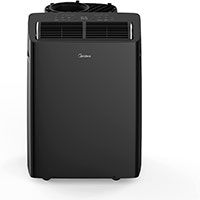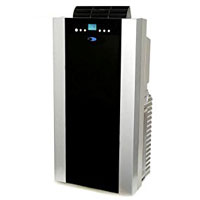(Jump to Portable Air Conditioner Top 10 List 2022 – based on total user reviews)
The True Portable Air Conditioner vs Alternatives
Portable air conditioner units are becoming increasingly popular in recent years. Here we’ll be focusing on what we’d call a true portable air conditioner. That is one that operates similar to any car, window or central AC – running with a condenser, compressor, evaporator and refrigerant. We’re going to cover all the points in deciding whether a portable air conditioner is suitable for you and which ones are best according to the thousands of user reviews.
Searching the term ‘portable air conditioner’ online also brings up several other types of contraptions which attempt to cool the air like swamp coolers, battery powered air coolers, and DIY ‘redneck’ ice chest air conditioners. To get straight to the point, attempts to significantly cool a room, or even inside a car with anything not built with the above mentioned air conditioning components is more or less wishful thinking.
 There are many videos online about how to make a do it yourself $8 air conditioner. These claim to provide cooling power by such simple tricks as just combining an ice cooler with a fan, making an air vent and filling it with ice.
There are many videos online about how to make a do it yourself $8 air conditioner. These claim to provide cooling power by such simple tricks as just combining an ice cooler with a fan, making an air vent and filling it with ice.
We wanted to know if any of these gizmos really works or is it just a bunch of hot air. And we wanted to know how true portable air conditioners stack up to window ac’s. We scoured the internet for countless hours comparing information, watching videos, reading tons of reviews and doing some of our own tests. Here’s what we found:
Evaporative Coolers & Ice Coolers – Very Limited Spot Cooling
 If you’ve ever had your car AC stop working during the summer and found out it would cost $1000 to replace a compressor or condenser, you may have found yourself searching online for any possible alternative. I had this happen and I was hopeful when I found all these do it yourself ice cooler ac videos.
If you’ve ever had your car AC stop working during the summer and found out it would cost $1000 to replace a compressor or condenser, you may have found yourself searching online for any possible alternative. I had this happen and I was hopeful when I found all these do it yourself ice cooler ac videos.
My own testing and extensive research has concluded these makeshift inventions at best can only provide a few minutes of cool air within a couple feet. All of the testing I found online with ice chest coolers concluded that none of them can actually reduce the temperature in even a small room by more than a few degrees for a few minutes. These seemingly nifty devices are really no more than very limited spot coolers.
You can get a good idea by searching on Amazon for ‘portable car air conditioner’. You will see only a very few of these type of items with only a small number of less than stellar reviews. There’s a couple of coolers which run on a 12 volt cigarette lighter type outlet. But a a 12 volts car battery can only power the fan used in these type of ‘air coolers’. There’s not nearly enough power in one car battery to run a typical window ac or the type of electric powered portable air conditioner we will be covering here.
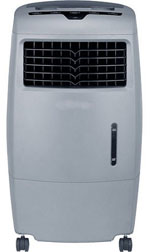 Swamp coolers on the other hand, also called evaporative coolers, run on very low power and may be a little helpful in places where there’s extremely low humidity, places like Colorado, Arizona & New Mexico. Old homes in places like these were sometimes equipped with evaporative coolers.
Swamp coolers on the other hand, also called evaporative coolers, run on very low power and may be a little helpful in places where there’s extremely low humidity, places like Colorado, Arizona & New Mexico. Old homes in places like these were sometimes equipped with evaporative coolers.
The general concensus though is that all these type of evaporative coolers and ice coolers really don’t help much to beat the heat. Searching online for ‘portable air conditioner’ you may come across some of these swamp coolers and ice coolers, though there’s really just a few of them with a small number of not very good reviews. Of the few reviews a couple may claim they helped a little. Still some of them cost $300-$500, about the same as a real portable air conditioner.
To be fair, let’s just say that a few folks may find these ice coolers and swamp coolers helpful under certain conditions and within a very limited space. The MightyCool is one item which has at least a few youtube reviews claiming it puts out enough cool air to help if sitting in front of it. But don’t expect much cooling from these. If you are looking for anything comparable to the type of cooling power you’d expect from a window AC or central AC, we can put aside all these type of so called portable air conditioners.
Zero Breeze Innovative Battery Powered Portable Air Conditioner
 (Update Feb 2022: The following segment on the Zero Breeze was done in 2019 when the product was yet to be released. It’s now been available on Amazon for a year & unfortunately the reviews are not very good. It seems that for now, an effective battery powered portable air conditioner is still mostly a dream. Check out the Zero Breeze reviews)
(Update Feb 2022: The following segment on the Zero Breeze was done in 2019 when the product was yet to be released. It’s now been available on Amazon for a year & unfortunately the reviews are not very good. It seems that for now, an effective battery powered portable air conditioner is still mostly a dream. Check out the Zero Breeze reviews)
There is one Kickstarter company though that could be somewhat of a game changer in the realm of portable air conditioning. They’re currently developing what they call the Zero Breeze, a battery powered 1100 BTU portable air conditioner. They claim it will be able to cool a 50 square ft room to 44 degrees F for 5 hours on battery power.
If this product truly delivers it will be a one of a kind – a fully portable battery powered air conditioner running with a condenser, compressor, evaporator and refrigerant. The Zero Breeze is similar in this way to any true portable air conditioner. The main difference with Zero Breeze is that it will run off of battery power (as well as electricity) and will weigh only 14 pounds, where most electric portable air conditioners weight 55-85 lbs.
As mentioned, the electric powered portable air conditioners currently on the market will not normally run on a 12 volt car battery. But the Zero Breeze is being geared to run off of the same super efficient batteries used by Tesla with their electric vehicles and solar panels. If it does deliver it will certainly be an innovative breakthrough in portable air conditioning. Their prototype is out and the unit is soon to be on the market. We shall see if it will live up to it’s claims.
Portable Air Conditioners Compared to Other Air Conditioning Systems
 The many portable air conditioners available today operate similarly to any window ac, but with several key differences. There are several pros and cons as well which we shall cover. Portable air conditioning is more of a recent development and the technology is rapidly improving. It’s possible that newer models are significantly more effective and efficient than models from 2 years ago.
The many portable air conditioners available today operate similarly to any window ac, but with several key differences. There are several pros and cons as well which we shall cover. Portable air conditioning is more of a recent development and the technology is rapidly improving. It’s possible that newer models are significantly more effective and efficient than models from 2 years ago.
Portable air conditioners though are generally not considered the most efficient cooling systems when compared to other air conditioning systems. Window ac’s are believed to be more efficient that portable air conditioners. However, for well insulated, not too large rooms and certain situations where a window ac will not do, a portable air conditioner can be a great option. There are many reviews of buyers who are very pleased with them.
There’s several types of air conditioning systems used in homes and businesses: mini splits, central ac, window ac, through the wall ac’s (PTAC – common in hotels) and portable ac’s. Mini split ac’s have become the most popular whole house systems due to being ductless and their high efficiency, being the most efficient of all these. Central ac is best suited for places with ducts, though not quite as efficient because of the limited control over which rooms are cooled. Window ac’s, wall units and portable ac’s all are designed to mainly cool one room.
Though portable ac’s are generally not considered the most efficient of them all, they do have specific advantages. There is a huge demand for air conditioning in situations where only a portable air conditioner is suitable. The portable air conditioner is the most highly searched for type of air conditioner online. Manufacturers are racing to improve their products and meet the booming demand. The technology is already quite good with thousands of online reviews of satisfied owners. Portable air conditioners will only continue to improve.
Let’s get right to the main point now and summarize the pros and cons of portable air conditioners. Then we’ll discuss each.
(Jump to Portable Air Conditioner Top 10 List 2017 – based on total user reviews)
Pros and Cons of Portable Air Conditioners:
Pros
- No installation costs, quick and easy to setup and no ductwork needed, no building modifications or permits needed to setup
- They are suitable in some situations where no other type of ac is an option
- Portable, convenient and versatile: can be used in various places like rooms, offices, server rooms, camper or tent (where there’s an outlet), poolside, garage, as a spot cooler and backup ac system. Great for renters / people who move a lot
- Efficient for cooling only certain rooms vs the whole house like central AC
- Some units can also serve as a standalone or all in one heater, dehumidifier, air purifier and fan
- Uses less window space than window ac
- Easy to move room to room, take on the go or store away
- Relatively inexpensive to maintain, mostly just requires to be kept internally clean for reliable service
- Can serve as a backup ac and can supplement central air conditioning
Cons
- Water drainage & exhaust tube required. Emptying water may be excessive on models required to be emptied manually
- Generally less efficient than a window AC and noisier due to entire unit being inside
- Not energy star certified like window ac’s
- Price can average $50-100 higher than equivalent capacity window ac
- Portability limited by exhaust tube length & where there’s a window and outlet
- Takes up floor space & might look somewhat makeshift
- Locking the window can be a security issue to deal with like with any window ac
After considering the advantages and disadvantages and having decided to make the purchase we can start looking for the best portable air conditioner to meet our needs. The main considerations are finding the right size and priced unit that can do a reasonable job cooling and dehumidifying with minimal noise. And you probably want one that also looks decent and is easy enough to setup anywhere you may want to use it.
Relatively Quick and Easy No Cost Installation
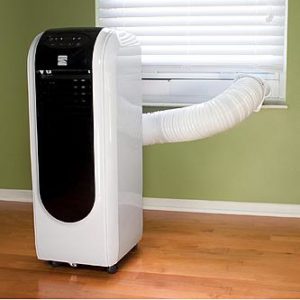 Though mini split air conditioners are considered as the top of the line most efficient system, one drawback is the initial setup and installation cost. It would be far more than any portable air conditioner. Obviously the same applies to central air conditioning. Even a window AC is not that easy to install because it is so heavy and needs to be properly positioned in the window. For the portable air conditioner there will be practically no setup cost or labor. And it can be installed using windows where a window ac won’t fit.
Though mini split air conditioners are considered as the top of the line most efficient system, one drawback is the initial setup and installation cost. It would be far more than any portable air conditioner. Obviously the same applies to central air conditioning. Even a window AC is not that easy to install because it is so heavy and needs to be properly positioned in the window. For the portable air conditioner there will be practically no setup cost or labor. And it can be installed using windows where a window ac won’t fit.
Installation Exhaust Kits and Power Outlet
The portable AC’s come with a window kit that is easily adaptable to most any windows. In cases where you want to setup through an extra large window or sliding glass door you will probably need to purchase a special adapter kit like this one:
Gulrear Portable Air Conditioner Sliding Door Vent Kit
Also if you plan to be often moving the unit from one room to another, you may want to purchase an extra window kit for convenience. The kit is an adjustable frame that your window closes down on. The frame has an opening that allows the exhaust tube from the air conditioner to pass the warm air to outside. There are also drop ceiling vent kits for places where there is no window to outside, like in server rooms or some offices. In such places the warm air can be vented into the drop ceiling or wall.
 Other than setting up the exhaust tube through a window, sliding glass door, or drop ceiling, installing the portable air conditioner is going to be as easy as just taking it out of the box, plugging it in and turning it on. Take note that the exhaust tube runs about six or seven feet so the unit will need to be placed within that distance from the window. It must also be near to a power outlet as you do not want to be using an extension cord. Using an extension cord with either a portable or window ac causes the possibility of overheating, short circuiting and fire hazard and can void the warranty.
Other than setting up the exhaust tube through a window, sliding glass door, or drop ceiling, installing the portable air conditioner is going to be as easy as just taking it out of the box, plugging it in and turning it on. Take note that the exhaust tube runs about six or seven feet so the unit will need to be placed within that distance from the window. It must also be near to a power outlet as you do not want to be using an extension cord. Using an extension cord with either a portable or window ac causes the possibility of overheating, short circuiting and fire hazard and can void the warranty.
Another advantage here is that the window kits on portable AC’s use much less window space. A window AC can take up half the window, blocking light and the view through the window.
Convenience, Versatility, and Ideal Situations for Portable Air Conditioners
In some situations a portable air conditioner is the only possible option. For instance, sometimes there are restrictions by landlords and home associations or permits are required for installing air conditioning systems. Modifications to buildings may be required and for other various reasons like aesthetics and energy costs property owners and associations may not approve of ac system installations, including window AC’s. Then there’s some places like basements having narrow windows or rooms with bay windows where a window ac also isn’t an option. In these cases the portable air conditioner comes to the rescue.
The portable air conditioner is great for much more than just a last resort option though. There are numerous situations where a portable air conditioner serves best or offers cooling where no other type of ac’s can.
(Jump to Portable Air Conditioner Top 10 List 2017 – based on total user reviews)
Easy Mobility for Renters and People Who Move Frequently
Some renters may not be allowed to have a window AC, what to speak of one in each room. Either way a portable air conditioner has the advantage of being much easier to setup, remove and transport. Plus it can be easily moved from one room to another unlike a window AC which weighs a ton and can break your back lifting. Portable air conditioners are made with handles and caster wheels for easy moving around from room to room.
Most units are very light weight enough for most people to pick up, move around, put in the car when on the go or store away (when storing the unit it is recommended to box it up to keep it free from dust). Their mobility is only limited by where there’s a power outlet and window to setup the vent. The only other exception to easy mobility is on thick shag carpets. This type of carpet can make it a little difficult to easily move around on the wheels, especially for elder folks.
Portable Air Conditioners Provide Efficiency for Cooling Individual Rooms
Portable air conditioners can cool an individual room instead of the whole house like central air conditioning does. Cooling unoccupied rooms could be wasteful. Though in places especially like Florida where there’s more humidity it is best to cool and dehumidify the whole house anyhow regardless of being occupied. You want to always keep the house dry and mold free. Still in a lot of places it’s not really necessary to always have ac running through the entire house. Cooling just rooms while occupied can save money on electricity bills. This can be done with mini splits and window AC’s as well.
Effective as a Supplement to Central AC and Backup AC
Portable air conditioners can also be effectively used in combination with central air conditioning. Cooling throughout the house can be reduced on the central system while the portable unit is used to keep any particular room more cool. Sometimes someone in the house just prefers their room much cooler. The portable air conditioner allows the individual to cool their room according to their preference.
It can also help as a central ac supplement when there are hot spots in the home. In this case it could possibly assist the central AC to operate more efficiently. The overall energy bill may or may not be reduced however. It depends on the situation. And while a house may already have a central or mini split system, in case the system ever malfunctions, it is nice to have a backup AC to survive until the main system is repaired.
Great for Campers, Trailers, Mobile Homes, Tent, Garage or Poolside.
Small spaces like those mentioned here are ideal for a portable air conditioner. Campers and trailers may have a roof mounted AC, but if not, or if the unit is in disrepair, then it’s a portable AC as the ideal replacement. In times when people want to hang out in the garage like during a party or whatever, the portable air conditioner can provide additional cooled space. When camping, so long there is an electrical outlet, you can camp in a tent with air conditioning. You can just run the exhaust hose out where the tent door zips up, or otherwise do a small modification. For using a portable AC outside in the open like at the poolside, you cannot expect cooling far from the unit, but sitting near the ac can provide a continuous cool breeze to help beat the heat.
Offices and Computer Server Rooms
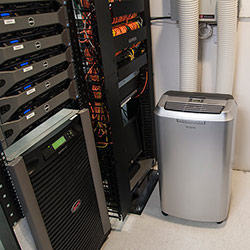 Offices and server rooms are another common place for portable ac’s. For server rooms they can be used as a primary or supplemental cooling source. Some offices use the portable units only on the weekends when the central AC is turned off.
Offices and server rooms are another common place for portable ac’s. For server rooms they can be used as a primary or supplemental cooling source. Some offices use the portable units only on the weekends when the central AC is turned off.
There are both residential and commercial air conditioners available. Residential units range from 6000 to 14000 btu while commercial units can run from 6000 to 60,000 btu. So when needed, there are very powerful portable units that can serve as a primary cooling source in server rooms.
In such places there may be no window or air vent readily available. As mentioned the air vent can be fixed into a drop ceiling, wall, or otherwise led out through an adjacent room via a hole in the wall provided the exhaust tube is not extended too far. The air conditioning unit will also dehumidify the room which is very important for computer equipment.
Can Serve As All In One AC, Heater, Dehumidifier, Air Purifier and Fan
 Portable AC’s are available with numerous features to choose from. Some models provide all of these features or a combination. They can be used for these features alone. Most models can be used as a standalone dehumidifier. The dehumidifier and air purifier features are especially helpful for persons with asthma and allergies. They remove dust mites and pathogens from the air and prevent mold from forming. Those with a heater work like a heat pump providing both cooling and heating.
Portable AC’s are available with numerous features to choose from. Some models provide all of these features or a combination. They can be used for these features alone. Most models can be used as a standalone dehumidifier. The dehumidifier and air purifier features are especially helpful for persons with asthma and allergies. They remove dust mites and pathogens from the air and prevent mold from forming. Those with a heater work like a heat pump providing both cooling and heating.
And there are several other features to look for like programmable thermostats with timer. You can set the temperature to reduce power use while away and have it automatically bring the temperature back to comfort range for when you arrive home.
Minimal Service to Maintain In Good running Condition
The last benefit on our list is regarding the maintenance on a portable unit which is relatively easy. The main thing is to keep air flowing freely by keeping the filter and condenser coil clean. You need to regularly clean or replace the filter. A clogged filter and condenser coil is the main problem for any air conditioner. So don’t forget to check yours regularly. Some units however do not have a separate filter for the condenser coil. If the coil were to get clogged with dust the unit would have to be taken apart to clean. It is much better if the unit has a separate filter for the condenser coil. Manufacturers recommend cleaning the unit weekly, which may sound a little much but would ensure many years of service.
Portable Air Conditioner Disadvantages:
Water Condensation
Let’s now get into some of the perceived disadvantages of the portable air conditioner. With regards to maintenance, we mentioned cleaning regularly to keep it running well. But some units may also require the added maintenance of manually emptying the water condensation that accumulates through dehumidification. A window AC sits half outside the window and the water just drips or evaporates outside. With a portable AC, because the entire unit is inside, the water needs a place to drain or must be emptied.
Units have a few different ways of handling this and it’s one of the features you’ll want to consider, as drainage may be considered the main drawback of a portable air conditioner. Some units are self evaporating and will evaporate the water out through the exhaust tube going out the window. Other units have a condensate pump that will pump the water out through a hose that also connects to the window kit along with the exhaust tube. Some units just have a tank that fills up and must be emptied when full.
With the tank only type the unit would shut off when the tank is full. This would probably be the least convenient especially in very humid places. Depending on the humidity it it could be necessary to dump the tank anywhere from once a week to few times daily. However many units use a combination of a tank combined with either a pump or self evaporation. Some units use self evaporation alone without a tank.
Portable AC’s Generally Less Efficient
Because the portable air conditioner is completely inside, compared to half outside like a window AC, they also tend to be less efficient and noisier than window AC’s. The portable AC cannot remove heat through the exhaust tube alone as efficiently as a window AC which transfers the heat directly to outside. The AC is generating it’s own heat as well, which also has to be moved out through the exhaust hose.
Single vs Dual Exhausts
 There are some models which use dual exhaust hoses in attempt for greater efficiency. There are differing opinions on whether they actually have any significant advantage. However, if anything, our research on the overall opinion concludes that the dual exhaust models may be only very slightly more efficient, but not anything much you will notice on your bill.
There are some models which use dual exhaust hoses in attempt for greater efficiency. There are differing opinions on whether they actually have any significant advantage. However, if anything, our research on the overall opinion concludes that the dual exhaust models may be only very slightly more efficient, but not anything much you will notice on your bill.
Single hose models pull in warm air, cool the air and return most of it into the room. Some of the air cools the unit as it passes out the exhaust. This process will pull in an equal amount of warm air from outside the room which makes the process not fully efficient as a window AC.
A dual hose model does not pull in air from outside the room. Rather, one hose pulls in air from outside to cool the unit’s compressor and then passes it out through the other hose. Because it uses warmer air from outside it also has to use two fans to assist the cooling process, rather than one. This ends up being not much more efficient than the single hose model. Though some reports do claim they believe that dual hose models work more efficiently in places with a lot of hot weather. They advise the single hose models in places with more mild weather and occasional heat waves. Either way, the single hose models are more popular for the simplicity and better appearance of having just one hose.
Efficiency Factors and Tips
The efficiency of a portable AC, like any AC system, will depend on several factors like the units’ BTU’s, size of the room, how well the room is insulated and how much sun or shade there is. Keeping a fan running (especially a ceiling fan) while the room is occupied can also help reduce energy usage. With more air circulation it’s possible to keep a thermostat about 3 degrees higher and still feel the same comfort. Also placing the portable AC as close to the window as possible will help efficiency. The longer the distance that warm air must pass through the exhaust to outside, the more warm air which can escape through the exhaust hose back into the room. The exhaust hoses may not be perfectly insulated. You can improve this by putting some black foam insulation tubing around the exhaust hose.
Portable vs Window AC Efficiency
Both window AC’s and portable AC’s are really designed for cooling single rooms. A window AC though, under certain conditions can serve to cool even a few rooms where there’s good airflow. And it can cool large rooms no problem. A portable AC is less likely to be able to cool as much space. And a window AC generally will cool a space more quickly.
Also there are many window AC’s which are Energy Star rated. Portable AC’s though do not have Energy Star Ratings. There are no current regulations established with portables being more of a newer technology. It does not mean that there are not energy efficient portable AC’s, it’s just more difficult to know which one’s are most efficient when shopping for them.
Still, portable AC’s are rapidly improving and there are already many available with a proven record based on hundreds of reviews. Many satisfied customers report that their portable AC does very well cooling even large rooms and quickly enough at a decent cost for electricity. It will all depend on the room conditions and getting a model with the right amount of BTU’s for your sized space.
Energy Efficiency Ratings and BTU’s
Though portable AC’s do not presently have Energy Star Ratings, they do have an EER or Energy Efficiency Rating. The EER along with the number of BTU’s (British Thermal Units) can help to determine a suitable model. The EER determines the cooling capacity in terms of BTU’s to watts. A 10,000 BTU that uses 1,000 watts/hr will receive an EER of 10. Portable and window AC’s are required to be rated at least 8. They range from 8 – 12 EER. An EER of 10 or above is considered highly efficient. Still many have a 9.5 EER which is acceptable but worth considering as there’s others rated more efficient.
A higher EER rating will likely come with a higher price for a unit of equivalent BTU’s. For example there could be 2 units both 10,000 BTU, one with an EER of 8.3, and the other being 10 which costs $100 more. Recouping the $100 in energy savings could take about 4 years if the unit were being used mainly just for summer – 8 hours a day for 5 months at .10/kWh. If the unit were to be running constantly than then the energy savings would pay off much quicker.
The BTU number will help determine what size space the unit is suitable for. Portable units range from 9000 to 14000 BTU’s. Across the web there are varying recommendations for how much BTU is suitable for different sized spaces. There is however no fixed standard of measurement. We’re giving you the Energy Star Recommendations. Choose the appropriate size BTU for your space to get the most cooling efficiency.
- 600 sq ft – 14000 BTU
- 400 sq ft – 12000 BTU
- 300 sq ft – 10000 BTU
- 200 sq ft – 8000 BTU
Room conditions to consider when choosing BTU’s.
- Add or subtract 10,000 BTU depending on if the room is excessively sunny or shady.
- 4,000 extra BTU needed for kitchen use.
- 600 BTU extra needed per person for rooms occupied by more than 2 people.
Keep in mind that it really isn’t so easy to determine actual efficiency based on the BTU number and EER alone. It is possible for manufacturers to exaggerate on the BTU’s giving a higher number, or also to low ball the number to show a higher EER. So definitely take these numbers into account but we’d suggest that user reviews are going to be the best determining factor to help decide if a particular unit will do a good job for your space.
Can Be Louder Than Window AC or Other AC Systems
Another factor worth considering is whether the sound a portable AC makes will be an issue. On central and mini split systems the motorized compressor is outside, possibly even on the far side of the house where you won’t hear a thing. On a window AC the compressor sits right outside the window where sound is reduced, but if the unit is not perfectly seated it can rumble. With a portable AC, the entire unit sits inside, so you will hear the fan and compressor running. For some folks the sound can be a deal breaker on some models. For most users it’s not a problem.
Look for decibal ratings (dB) on models if noise is an issue for you. Portable AC decibal ratings range from 36-83, the lower the number the quieter. Most models come in around 53-68 (somewhere between a whisper and loud conversation). The quietest ones are rated 36-46. Quiet models are comparable to the sound of a fan. Noisy models are compared to a window AC’s sound on the outside of the window.
Will Need To Secure Window
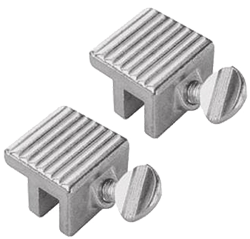 As with any window AC, the window will need to be secured as it will remain partially open and unlocked with the window kit in place. There are what’s called security window locks which can be added to the frame. You can also add a small window sensor alarm as well. Some owners have their window frame modified to put the hose directly through and be able to lock the window. You’ll have to consider what you’ll do for window security in each room where you plan to use the portable AC.
As with any window AC, the window will need to be secured as it will remain partially open and unlocked with the window kit in place. There are what’s called security window locks which can be added to the frame. You can also add a small window sensor alarm as well. Some owners have their window frame modified to put the hose directly through and be able to lock the window. You’ll have to consider what you’ll do for window security in each room where you plan to use the portable AC.
http://www.homedepot.com/p/Barton-Kramer-Safe-Mill-Security-Window-Lock-1504/100132597
Will Take Some Floor Space / Esthetic Appearance
A Portable AC is the only kind of AC that sits on the floor and takes up some space. Though they generally are not too bulky, like 15 ”x 18” x 30” high. And there will need to be at least 18 inches of clear space around it for air flow. There is also the exhaust hose and window kit which can look somewhat makeshift. For those who are more concerned about having a clutter free space these points are a disadvantage. But if keeping cool is more important this is no problem. You may also want to consider how nice the unit looks. Some users consider some models to have a better appearance than others.
Price of Units Can Be a Little Higher Than Window AC’s
The price of portable AC’s runs about $50-$100 more than a window AC rated to cool the same amount of space. The current price range of portables is about $300-$550 for residential units. So it’s not really too much different than window AC’s. As with many products since 2020, prices have increased about 10%. It’s likely going to be worthwhile in the longrun to spend a little more for better quality and get a unit that will provide many yeas of service.
We’d say that by far the advantages outweigh the disadvantages here when you need cooling and other kinds of AC systems are either too expensive upfront or just not an option. Considering all the advantages that only a portable AC can provide we can understand why the portable air conditioner is by far the single most popular type of AC system in online searches.
Purchasing The Best Portable Air Conditioner
Here’s some of the features you’ll want to look for:
- BTU’s
- EER (Energy Efficiency Rating)
- (dB) Decibal Rating (53-68 average for most models)
- Heater
- Dehumidifier
- Air Purifier
- Water Drainage: Tank + Self Evaporating or Pump
- Single or Dual Exhaust
- Programmable Thermostat
- Remote Control
- Wheels & Handles
- Lightweight
- Separate Filter for Condenser Coil
Top 10 Portable Air Conditioners 2022 (Based on total online reviews)
Here’s our list of the best selling, most reviewed portable air conditioners for 2022. We’ve updated this list since 2019 and since then all the models been discontinued & replaced with upgraded models. Some of the manufacturers like Honeywell, LG & Edgestar are no longer on our list & have been overtaken by Black & Decker, SereneLife, Whynter & Midea. All the units on the list have at least 4.5 stars. Keep in mind that practically any product, no matter how many good reviews there are, will always have some bad ones too. But these are the 10 with the most positive reviews.
|
|
 SereneLife SLACHT128 Portable Air Conditioner Several BTU Size Models, with Built-in Dehumidifier & Fan Modes SereneLife SLACHT128 Portable Air Conditioner Several BTU Size Models, with Built-in Dehumidifier & Fan Modes
|
 BLACK+DECKER BPP06WTB Portable Air Conditioner with Remote Control, 10,000 BTU, Cools Up to 250 Square Feet BLACK+DECKER BPP06WTB Portable Air Conditioner with Remote Control, 10,000 BTU, Cools Up to 250 Square Feet
|
|
|
|
|
 BLACK+DECKER BPP08WTB Portable Air Conditioner with Remote Control, 12,000 BTU, Cools Up to 350 Square Feet BLACK+DECKER BPP08WTB Portable Air Conditioner with Remote Control, 12,000 BTU, Cools Up to 350 Square Feet
|
 BLACK+DECKER BPP10HWTB Portable Air Conditioner with Heat and Remote Control, 10,000 BTU SACC/CEC BLACK+DECKER BPP10HWTB Portable Air Conditioner with Heat and Remote Control, 10,000 BTU SACC/CEC
|
|
|
|
|
|
|









